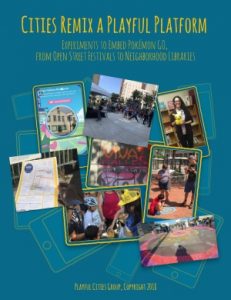
A new research report by American University provides case studies and best practices for cities to leverage games like Pokémon GO to achieve local goals
The popularity of augmented reality games is indisputable, beginning with Pokémon GO. But what if they also provide an opportunity to strengthen cities and communities? A new study from American University reveals how cities can leverage augmented reality (AR) games for public engagement. The report, “Cities Remix a Playful Platform: Experiments to Embed Pokémon GO,” offers case studies and lessons learned from trials conducted in 2017 by five cities.
Among several findings, the research provides a model for city leaders to use platforms like Pokémon GO to shape how players move through a city’s physical space. For example, in Philadelphia, neighborhood libraries integrated Pokémon GO with walking tours of famous murals and local landmarks. Another finding from the research is that cities can stimulate their economies by incorporating AR games in city events. San Jose recruited 35,000 Pokémon GO players with its open street festival, which reimagines local streets without cars, and, in the process, released more than $450,000 into the local economy.
This is the first major study to show how cities can harness the popularity of commercial games to draw attention to local areas and shape engagement in existing events. It details a series of experiments supported through a multi-year partnership between Pokémon GO creator, Niantic, Inc., and the John S. and James L. Knight Foundation, which invests in informed and engaged communities. The research was conducted independently by American University, through the AU Game Lab and the Center for Media & Social Impact (CMSI). The analysis is based on usage statistics from city events, surveys of players, and extensive interviews with city leaders.
“Our findings can help city leaders to identify new tactics to strengthen their communities,” said lead author Dr. Benjamin Stokes, a CMSI Faculty Fellow who studies civic engagement at the American University Game Lab. “For example, we tracked how Philadelphia shifted from bringing in tourists to connecting more residents across neighborhood divides. We found that the impact in cities changes, depending on how city leaders embed the game.”
Top lessons for cities that are considering similar strategies include:
(1) Adapt games for local events. Cities can adapt AR platforms to amplify local strengths and better reflect civic needs. In particular, cities can layer walking tours, scavenger hunts, and other activities on top of the game, adding value for existing players and integrating play with local campaigns.
(2) Invite player networks (not just individuals). Pokémon GO players often arrived in groups, including across generations and with social media networks poised for discussion. Recruiting is also easier through player and fan networks, and cities can help by tapping network leaders, beyond the usual open invitations.
(3) Focus digital activity near inviting and accessible physical spaces. Players often want to interact, but social mixing can happen more easily when cities position play near the right physical spaces with seating and food.
(4) Augment local culture. Games can simultaneously bring in global culture and amplify local culture. Increasingly, local culture may require city investments in the data layer to highlight local monuments, history, and cultural assets.
CMSI Director, Caty Borum Chattoo said, “This exciting and innovative research, part of CMSI’s ongoing commitment to studying civic storytelling, highlights the potential of playful platforms in civic storytelling and community building.”
Many of the local experiments were funded by Knight Foundation, in part to better understand how cities can shape engagement with technology. “Cities are going digital. This experiment explores how technology can improve efforts to get people out and into the community. We hope leaders use these lessons to take advantage of the inevitable growth in technology to foster more engaged communities,” said Sam Gill, Knight Foundation vice president for communities and impact.
Most cities collaborated with Niantic for their experiments. The vision at Niantic is unusually civic. “Niantic was founded on the core tenant of getting people off the couch to explore their local community,” said John Hanke, founder and CEO of Niantic, Inc. “Our goal is to provide amazing interactive experiences that not only deliver fun gameplay but help people learn about the history, culture, and society of the places around them. By turning city spaces into game boards, we’re hoping to bring communities together in entirely new ways.”
“Many of the players we interviewed were surprisingly networked,” said study co-author Aubrey Hill of American University. “They arrived in groups and coordinated in live chat, social media, and in person. This report points to how play can build local ties and reveals some of the networks emerging through play in our neighborhoods.”
Photographs from each city are available on the report website: http://playfulcity.net/pogo
